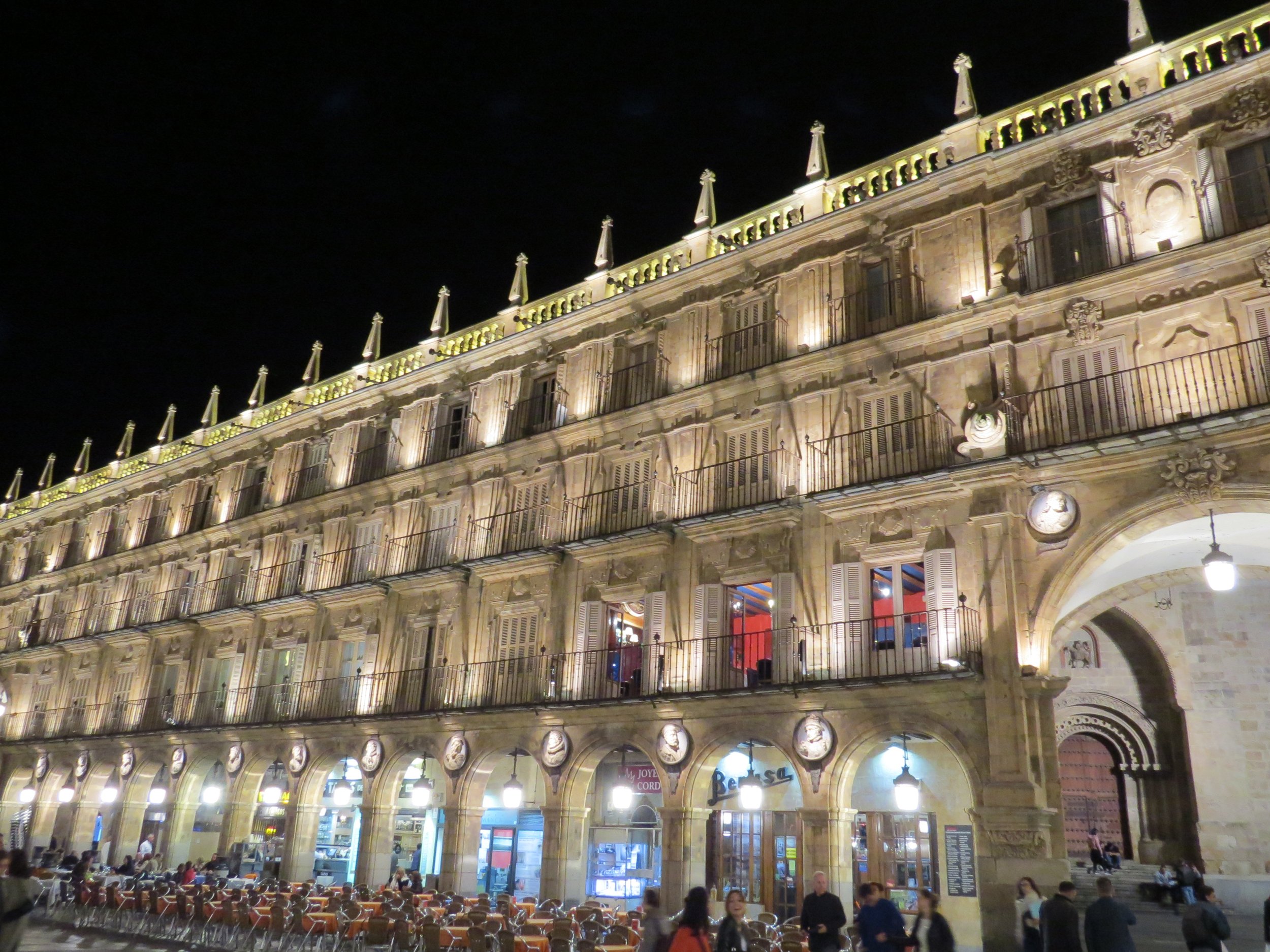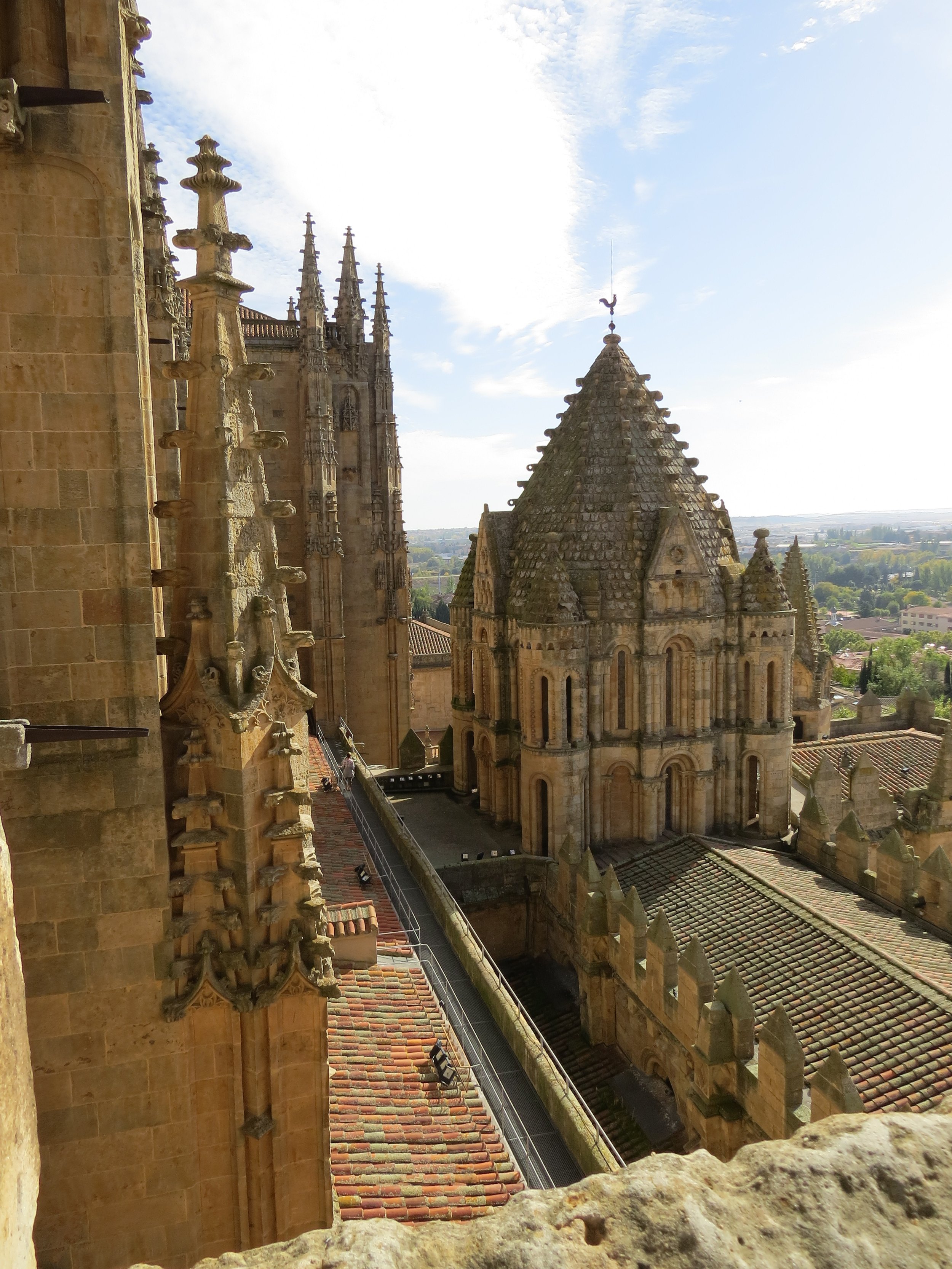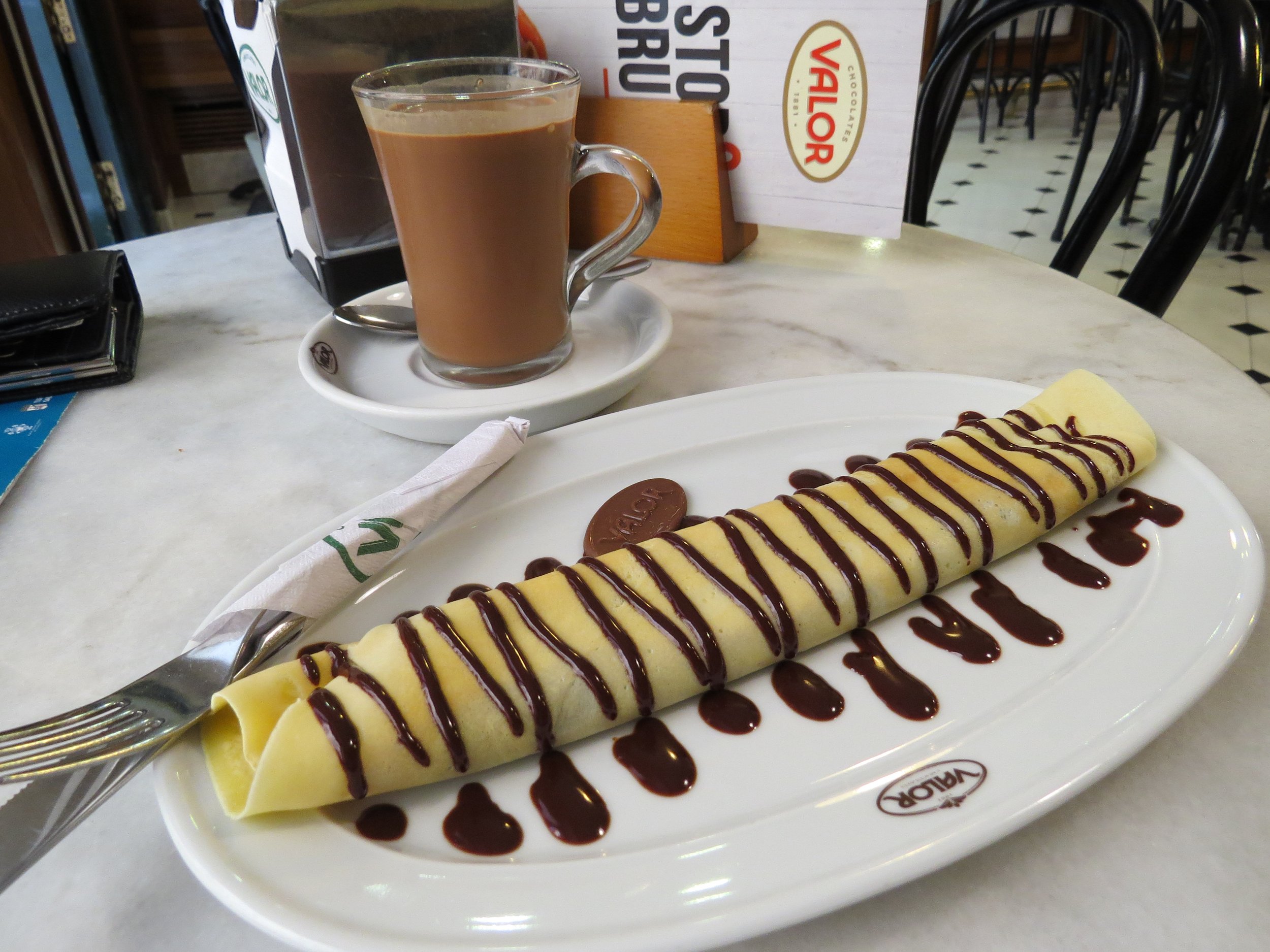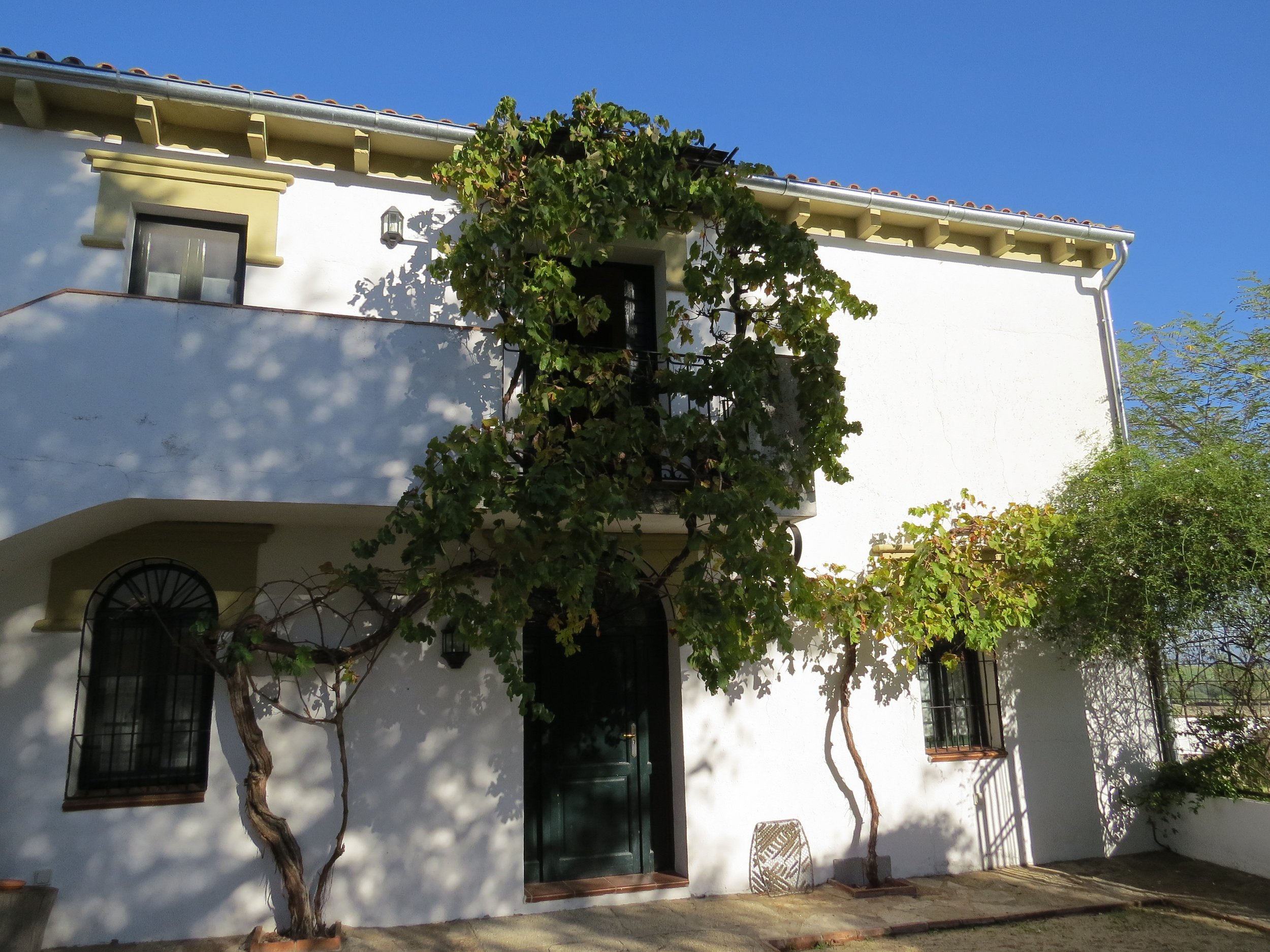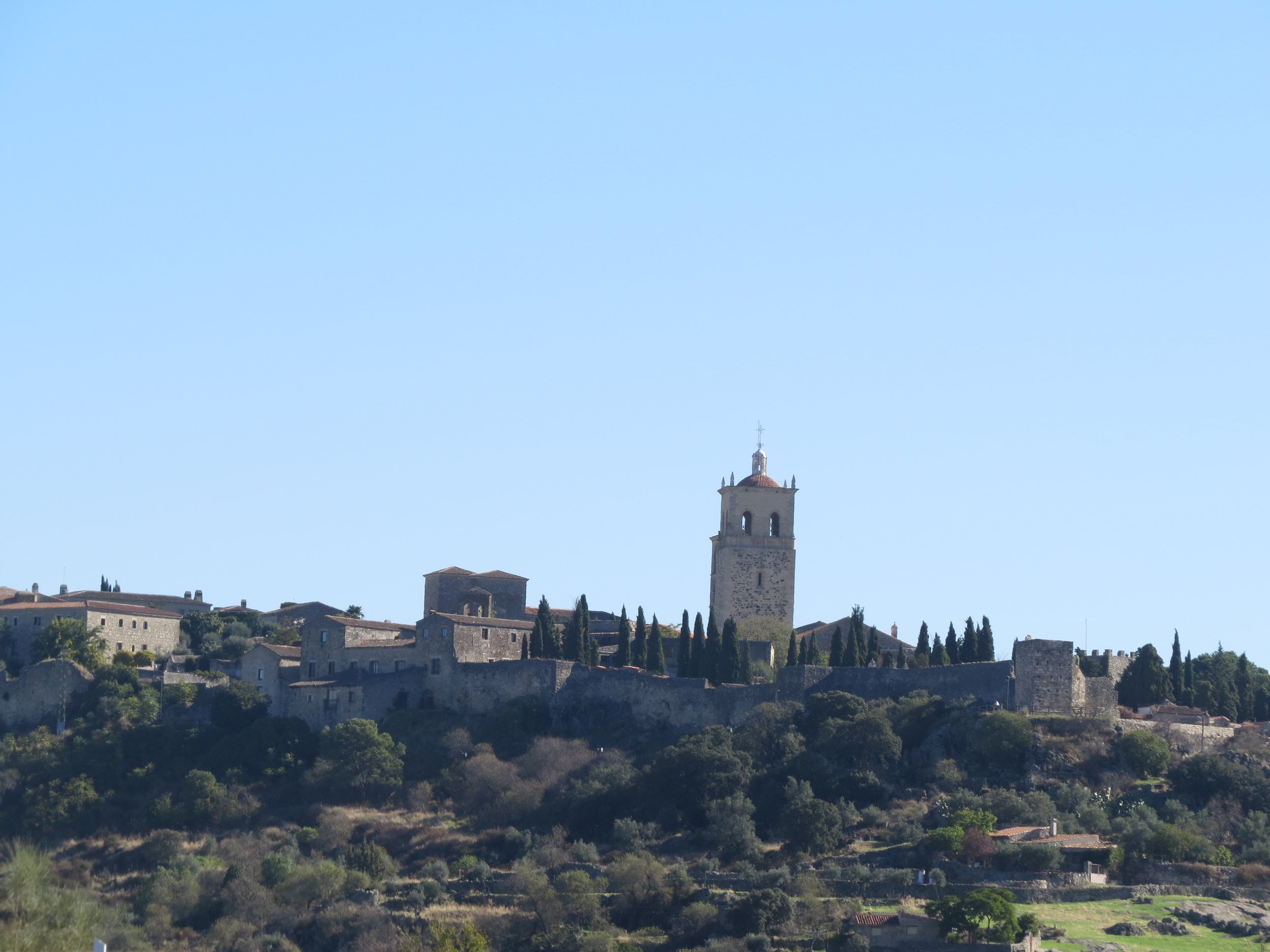Salamanca
Spain offers many wonderful hiking trails. But Kees found it sometimes difficult that he did not speak Spanish, especially when hiking in more remote regions. Along the Camino the Santiago you can get by with English, but elsewhere our Spanish was limited to “una serveza por favour!” So we found a school that teaches Spanish at all levels., in groups or to individuals. The city of Salamanca was recommended because of the pure Spanish spoken in this area. And we were happy to have a good reason to spend some time in this glorious city.
Salamanca’s city centre has been declared a Unesco World Heritage site, and rightly so. The buildings in the old city centre are all of large stone blocks, all the same sand colour. Even modern shops have conformed to the building standards - no neon signs or clashing building styles.
The central square, Plaza Major, is very ornamental with beautifully decorated façades. At night everything is bathed in soft yellow light.
The gates of the Plaza lead to different areas of the old town. It is said that Miguel de Cervantes studied at the University here, in the early 1600’s - the very building next to our Air BnB. Later of course, Cervantes wrote Don Quijote, bringing permanent fame to the area. It felt good to dwell in the shadows of literary ghosts.
Cervantes’ Don Quijote
We arrived by train from Madrid and walked the half hour through the historic city centre to our apartment. The apartment was listed as a simple room in a guest house. We haven’t seen the owner and there are not any services. But the bedding is clean, we have our own private bathroom and a small kitchen counter. It’s perfect for our time here as Spanish students. One of the first things we did was find a supermarket to buy things to make our own breakfasts and lunches.
We signed up for a week long of private lessons at Don Quijote Spanish Language School (www.quijote.org) This well known institute offers Spanish classes in different locations around Spain. The private lessons enable us to tell the instructor exactly what we want to learn: words and phrases applicable to hiking and traveling in the country. Two hours a day is more than enough for us. After that our brains are fried!
We focus on learning survival Spanish: how to order food, ask for a room, directions, etc. Kees discovered that he has been asking for “ser-VEY-sah” all these years but that is is pronounced ‘ser-BAY-thah” instead. Still, they always brought him beer…
English editors should be able to find jobs here, too. On a menu in a restaurant, a local soup called ‘sopa de Castilla’ was translated as ‘garlic soap’. And what I thought looked like deep fried shrimps, turned out to be fried pig lips! How do I say ‘bon appetit’ in Spanish?
After our week of lessons we knew we had learned something, when we used Google Translate to ask how much we had left on our phone card, and we recognized that the translation asked the store clerk ‘how much to turn left’…. We can now order beer ánd shoelaces in Spanish.
It feels good to walk outside, after breakfast in our apartment, and join the throngs of students walking to class in this ancient university city. Students from all over the world come to study at the University of Salamanca. We especially see many students of architecture around the city as they sit and draw arches and columns.
After our class, we buy fresh bread at the bakery and walk back home for lunch.
Then we hike in the area, for instance across the Roman bridge that is part of the Ruta de la Plata, a 1,000 KM long distance trail. We pop into churches and the public library, also known as the Shell House, or Casa de las Conchas.
Almost all stores and restaurants here close in the afternoon. Restaurants serve lunch from about 2 to 4 and then only drinks until 8 PM. We have to either have a very late dinner or find a rare place that caters to tourists by offering an earlier supper, a menu del dia. Stores close around 12:30 and then reopen round 5 PM for a few more hours.
It is fun to see the difference in culture. In restaurants and coffeeshops, large groups of women gather in the afternoon, they all talk at the same time, they visit, sip coffee or hot chocolate, talk some more. By 4 PM they go home but then don’t have dinner until maybe 9 PM. We’re told most Spaniards don’t go to bed until after midnight.
If you visit Salamanca, be sure to climb the Ieronimus Tower adjacent to the old Cathedral. You can buy a ticket to see the Cathedral but when you buy a ticket for the tower, you also see the Cathedral on the inside. At each level of the tower is an interpretive room with displays about the history or architecture, even a room with benches and beautiful organ music piped in. Once you reach the Cathedral roof level, a catwalk takes you out over the roof and into the Cathedral near the glorious ceiling. I am scared of heights but you can stay away from edges and there’s enough space not to feel scared. The views of the old city and surrounding area are very much worth the climb.
One of my favourite places was Escuelas Menores, an ancient garden at the university, surrounded by arched, covered porches. A tranquil place to stroll and rest. Inside one very old building (the walls are very thick and you have to stoop when going through the door), they uncovered a centuries’ old ceiling painting of the night sky above Salamanca. History is palpable here. Throughout the city centre musicians are busking, adding to the atmosphere: a guitarist, a violinist, a Spanish singer, all using the acoustics of the old stone streets to their advantage.
Another of my favourite places here is the famous Valor chocolate shop, where they serve thick melted chocolate in cups. But better yet was the hot or icy cold chocolate milk with chocolate crepes…
Before we came to Spain, I decided that I wanted to see the Extremadura region. Salamanca is not far from this area so after our week of Spamish lessons, we drove to Extremadura: a hilly and forested region in western Spain, bordering Portugal. The capital, Mérida, is known for Roman ruins, aqueducts and bridges. I read several articles about the area, specifically an article about one of the oldest, medieval pubs on the continent, which I wanted to see. Ironically, once we got here I could no longer find any information about the pub or its location…
Extremadura
Extremadura was described in many travel articles as a long-isolated region, a bit backward, not very popular with tourists, which made it attractive to us…. I was curious about its towns and history.
The region turned out to be different from what I pictured: not a deep, green valley but a dry region of rolling hills. However, we found lovely towns with a rich history, and enjoyed the lack of hordes of tourists. In fact, we often commented that we had entire roads to ourselves.
We started in Plasencia, driving south to Cáceres. We soon discovered that we were here during a local (October) holiday and ended up having to book several nights in one place to ensure we had a place to stay. We stayed just outside the village of Casar de Cáceres, in a lovely B & B called La Encarnacion, our room was in a remodelled barn. We were served a traditional Extremadura breakfast of warm bread, thick, soft cheese, paté and bread with tomato/pork salsa inside.
Many of the towns in this region boast medieval buildings: castles on a hillside, often a whole village still surrounded by thick stone city walls. Galisteo, just west of Plasencia, is an old village that is still completely surrounded by these walls, with only a few gates that offer entrance to the town. We had to park our car outside the city walls and walk to the town square with its ancient clock on city hall, chiming the hours as it had for centuries.
We spent one day in Trujillo, high on a hill side, the town is still partially surrounded by walls with a castle and ancient church guarding the corners. It is easy to stroll along the battlements and imagine enemy armies approaching across the plains… We walked up and down streets from the middle ages that weren’t much wider than 1.5 meter in some places, with purple and red bougainvilleas cascading down white stone walls.
Our final couple of days in the region were spent in Mérida, where the remains of some buildings were much older than the Middle Ages. Mérida boasts numerous Roman sites.
We found a lovely AirBnB in the old downtown core, enabling us to walk to the different sites. We started at Puento Romano, the longest (in length) surviving Roman bridge. From there, we walked to the Templo de Diana, a facade and pillars left standing among stores, coffeeshops and narrow alleys. We then hiked across town to two large Roman aqueducts, the most imposing one of which is the Acueducto de Milagros: 25 meter tall arches spanning an area of about 800 meters, displaying impressive stone work that has lasted almost 2,000 years!
If this history is what makes Extremadura unique, combined with first class pastries, ham, cheese and chocolate, then the area deserves a lot more visitors!
Resources:
Our Salamanca AirBnB: https://www.airbnb.ca/rooms/8078449?source_impression_id=p3_1647811893_Y3AkU%2B%2FQXghl%2FP1M
• https://www.spain.info/en/destination/salamanca/
• https://www.valor.es/historia-de-chocolates-valor/
B&B in Casar de Cáceres: https://www.clubrural.com/casa-rural/caceres/casar-de-caceres/casa-rural-la-encarnacion_125020



